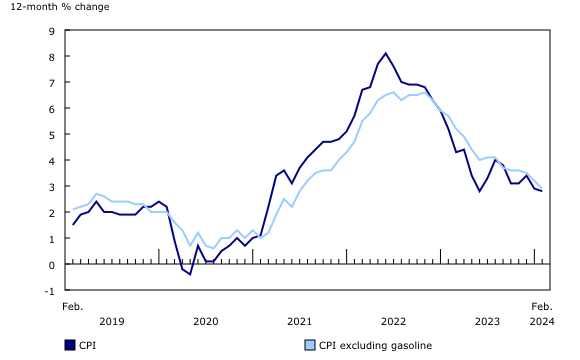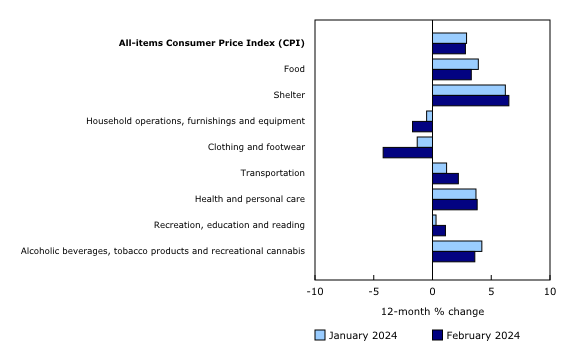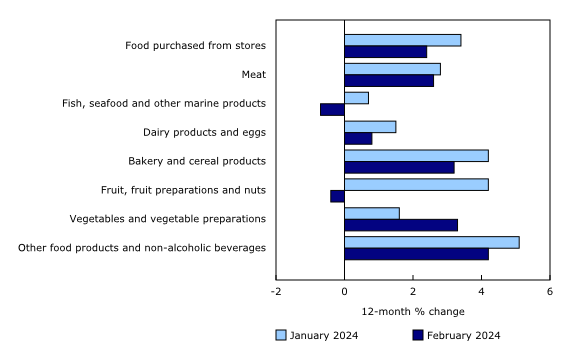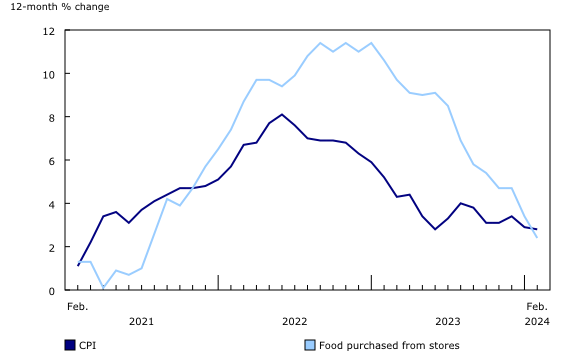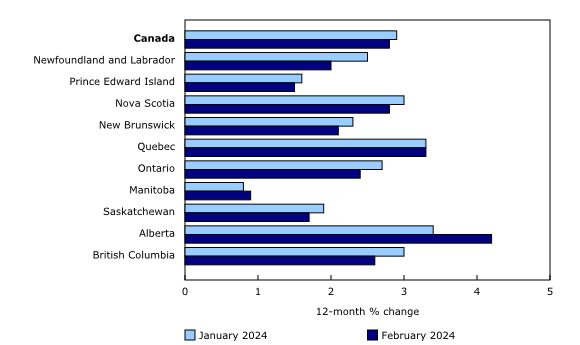Consumer Price Index, February 2024
Released: 2024-03-19
The Consumer Price Index (CPI) rose 2.8% on a year-over-year basis in February, down from a 2.9% gain in January. Notable contributors to the deceleration included the indexes for cellular services, food purchased from stores, and Internet access services. Offsetting the deceleration was a year-over-year increase in gasoline prices, which rose 0.8% in February, following a 4.0% decline in January.
Excluding gasoline, the headline CPI slowed to a 2.9% year-over-year increase in February, down from 3.2% in January. Prices for rent and the mortgage interest cost index continued to apply upward pressure on the headline CPI.
On a monthly basis, the CPI rose 0.3% in February, up from 0.0% in January. The largest contributors to the monthly increase were higher prices for travel tours and gasoline.
On a seasonally adjusted monthly basis, the CPI rose 0.1% in February.
Canadians pay less for cellular services and Internet access services
Consumers who signed on to a cell phone plan in February paid 26.5% less year over year, following a 16.4% decline in January. The year-over-year decline was driven by lower prices for new plans and increases in data allowances for some cellular service plans.
Similarly, prices for Internet access services fell 13.2% on a year-over-year basis in February, stemming from a monthly decline of 9.4%. The monthly price decline was attributable to specials offered by Internet service providers.
Grocery inflation continues to ease
Prices for food purchased from stores continued to ease on a year-over-year basis in February (+2.4%) compared with January (+3.4%). Slower price growth was broad-based with prices for fresh fruit (-2.6%), processed meat (-0.6%) and fish (-1.3%) declining, while other food preparations (+1.4%), preserved fruit and fruit preparations (+4.0%), cereal products (+1.7%) and dairy products (+0.6%) decelerated in February.
February was the first month since October 2021 that grocery prices increased at a slower rate than headline inflation. The slower price growth is partially attributable to a base-year effect, as food purchased from stores rose 0.7% month over month in February 2023, due to supply constraints amid unfavourable weather in growing regions, as well as higher input costs.
While price growth for groceries has been slowing, prices continue to increase and remain elevated. From February 2021 to February 2024, prices for food purchased from stores increased 21.6%.
Prices for gasoline increase
Year over year, gasoline prices rose 0.8% in February, following a 4.0% decline in January.
Month over month, prices for gasoline increased in February (+4.0%) amid higher global prices for crude oil following expectations that some oil-producing countries would extend voluntary production cuts.
Consumers pay more for travel tours in February
On a year-over-year basis, consumers paid more for travel tours in February (+4.8%) compared with January (+3.3%) due to seasonal demand for travel to various destinations in the United States, Mexico, and the Caribbean.
Explore the Consumer Price Index tools
Check out Statistics Canada's new Food Price Data Hub, which features a variety of food price related statistics, articles and tools.
Check out the Personal Inflation Calculator. This interactive calculator allows you to enter dollar amounts in the common expense categories to produce a personalized inflation rate, which you can compare to the official measure of inflation for the average Canadian household—the Consumer Price Index (CPI).
Browse the Consumer Price Index Data Visualization Tool to access current (Latest Snapshot of the CPI) and historical (Price trends: 1914 to today) CPI data in a customizable visual format.
Regional highlights
Year over year, prices rose at a slower pace in February compared with January in seven provinces.
Prices in Alberta rose at a faster pace due in part to natural gas prices, which accelerated on a year-over-year basis in February (+15.1%) compared with January (-18.7%).
Did you know we have a mobile app?
Get timely access to data right at your fingertips by downloading the StatsCAN app, available for free on the App Store and on Google Play.
Note to readers
Visit the Consumer Price Index portal to find all Consumer Price Index (CPI) data, publications, interactive tools and announcements highlighting new products and upcoming changes to the CPI in one convenient location.
Updated data source notice
With the release of the March 2024 CPI, a new data source will be incorporated for select regions of the Fuel oil and other fuels index, which represents 0.21% of the 2022 CPI basket and is part of the shelter component. The new data will result in price changes captured for all weeks in the month, similar to the gasoline index. Standard CPI collection procedures will continue for regions for which this data source is not available.
In recent years, Statistics Canada has increased relevance by incorporating new alternative data sources and methods for CPI calculation. More alternative and administrative data sources are used in the CPI calculation, replacing traditional in-store price collection and other sources that may become unavailable. Statistics Canada continues to adapt and prioritizes the quality of data sources, methods, timeliness, and the cost and level of detail, to ensure the ongoing accuracy and relevance of the CPI.
Real-time data tables
Real-time data table 18-10-0259-01 will be updated on April 2. For more information, consult the document, "Real-time data tables."
Next release
The Consumer Price Index for March will be released on April 16.
Products
The "Consumer Price Index Data Visualization Tool" is available on the Statistics Canada website.
More information on the concepts and use of the Consumer Price Index (CPI) is available in The Canadian Consumer Price Index Reference Paper (62-553-X).
For information on the history of the CPI in Canada, consult the publication Exploring the first century of Canada's Consumer Price Index (62-604-X).
Two videos, "An Overview of Canada's Consumer Price Index (CPI)" and "The Consumer Price Index (CPI) and Your Experience of Price Change," are available on Statistics Canada's YouTube channel.
Find out answers to the most common questions posed about the CPI in the context of the COVID-19 pandemic and beyond.
Contact information
For more information, or to enquire about the concepts, methods or data quality of this release, contact us (toll-free 1-800-263-1136; 514-283-8300; infostats@statcan.gc.ca) or Media Relations (statcan.mediahotline-ligneinfomedias.statcan@statcan.gc.ca).
- Date modified:


